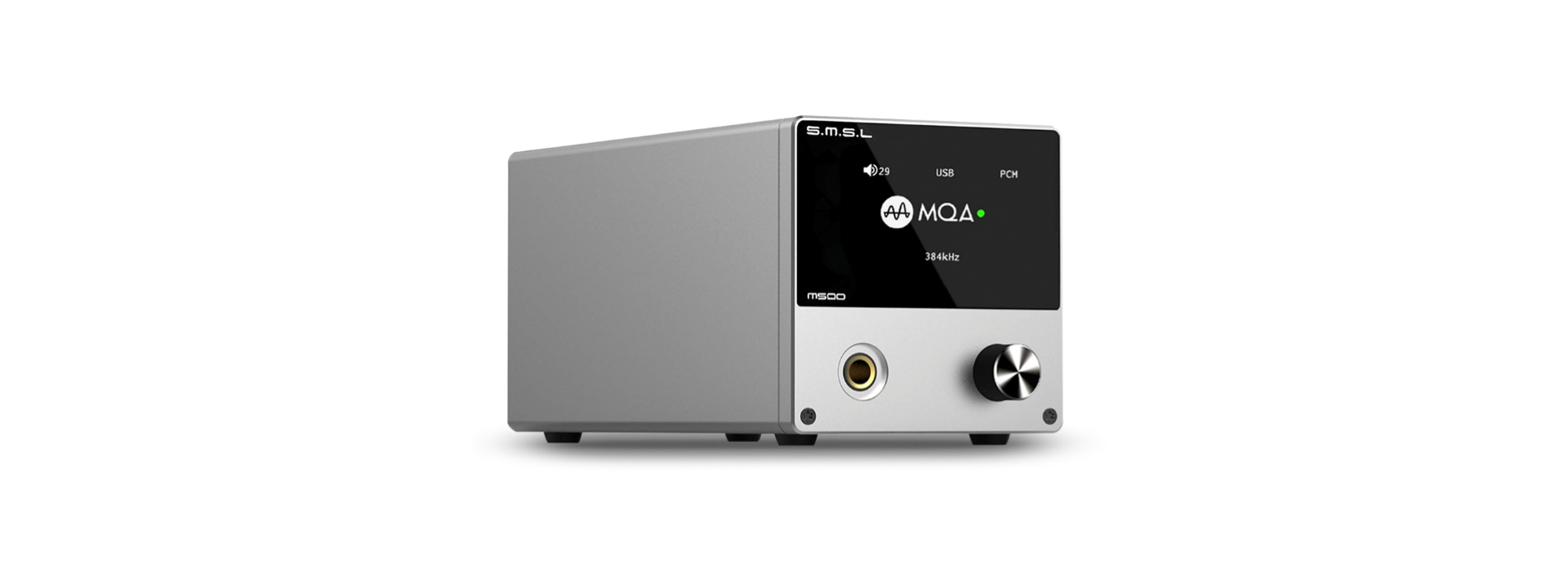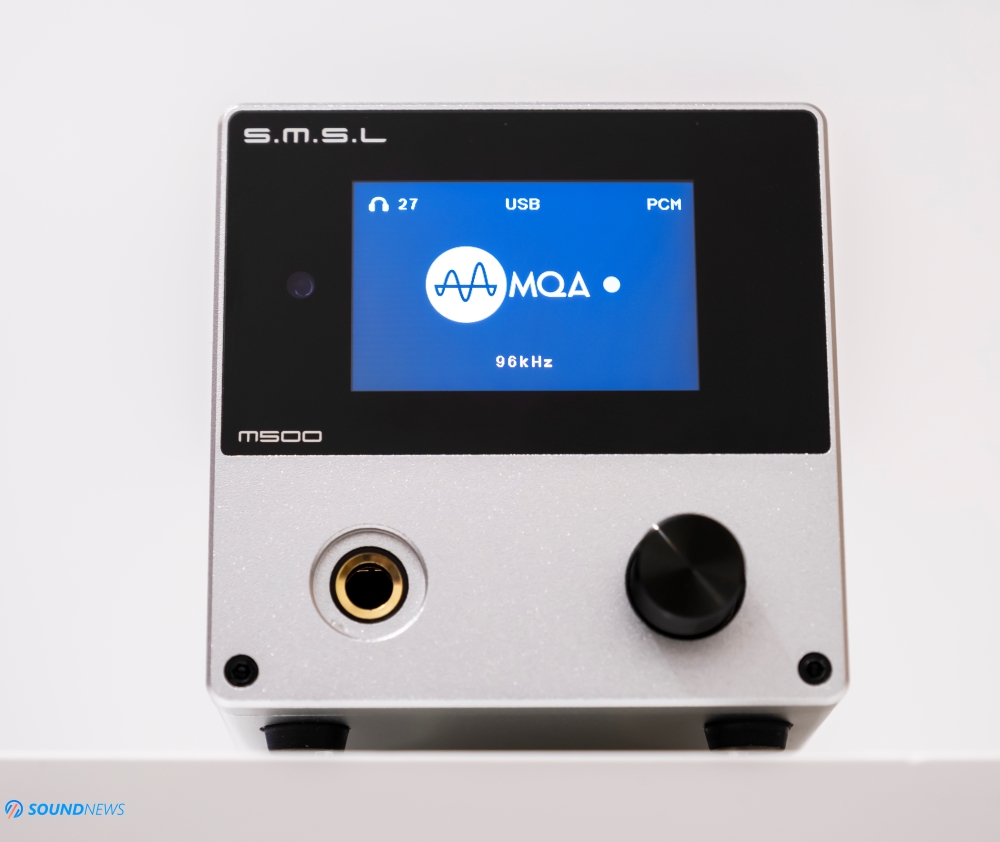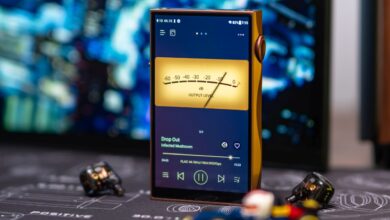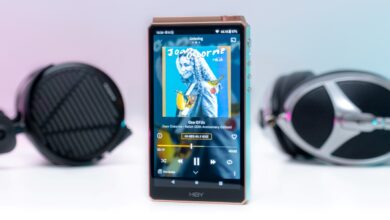
Disclaimer: SMSL M500 was send to us as a review unit in exchange for our honest opinion. We thank team Apos Audio for this opportunity.
My video review:
Kunal of Apos Audio kindly provided the review sample to us and introduced to the SMSL family of products. This is our first contact with SMSL but it doesn’t mean we didn’t know about them. What is kind of amazing is that SMLS Audio just hit 10 years on the market but their presence on the West market is quite fresh, they seen a boom and a high interest once they started working with Drop (formerly Massdrop) and released affordable but good sounding equipment. SMSL Audio is mostly specialized in the desktop-fi area (portable and desktop DACs, headphone amps and combos) but they offer few integrated and power amps for loudspeaker aficionados.

Meet the Family
The coolest product line in the SMSL family to us is their M line of desktop DACs. I’m quite sure you’ve seen at least once their latest designs with an elongated and colorful body. The super tiny and bus powered M100 DAC to this day is praised as a very good entry-level DAC in the sub $100 category. M300 DAC added balanced outputs on the back and a much higher-end AKM4497 DAC chip was used for a better performance.
M500 that we are testing today is their top of the line DAC, SMSL added a powerful headphone section in case you’ll want to use it in front of your PC.
Unboxing & Package Contents
Unboxing experience was excellent for me! It came double-boxed for extra care; the product box is fairly small and once I opened it up, I was pleased to find lots of foam for additional protection. Inside it you’ll find: the M500 unit, a nice looking and SMSL branded remote control, a USB type-B cable, a power cable, a warranty card and a user manual. That is basically everything you need to start your listening session.

Design & Build Quality
I was actually stunned by the size of M500, it looks big in pictures but in reality, it is really small. At only 8.5 x 8.8 x 19.7 cm and weighting only 0.91 Kg (that is with its internal power supply and thick aluminum body) this is basically the smallest DAC and headphone amp combo with balanced outputs on the back that carries a desktop class DAC chip inside.
I’m actually digging its looks and taking into consideration that it has a dual PCB stacked on each other, its design makes a lot of sense.
The entire body is made out of thick anodized aluminum, I have the silver version, there is also a black and a red option if you would like to add a bit of color. The front panel is really thick, at about 8 mm thickness inserting heavy duty headphone plugs will not move the unit from the table. Underneath it 4 rubber feet will make sure it will not move around when changing volume settings or making adjustments in the menu.
Controls & Connectivity
On the front panel there is a very easy to read and a really bright LCD screen provided by LG. At only 2.2” it doesn’t attract a lot of attention and I like that it has 9 display brightness modes. I am often listening to music late night and don’t like to be bothered by lights.
On the front you have just a single ¼” (6.35mm) headphone jack and a small volume wheel that also works as a stand-by button, a long press on it will put the unit in stand-by mode.
The back-panel looks stuffed with lots of inputs and outputs: you have one coaxial input, two optical inputs (I used those with a TV and with a PS4 PRO) and an MQA-enabled USB input. It has single ended and balanced outputs on the back via RCA and XLR. I’m glad M500 is not bus-powered, it uses 2 pole AC cable, so I am pretty sure it will have better dynamic swings compared to M100 and M300.

Under the hood of M500
The more I delve deeper and research about it, the more I am impressed and I am questioning myself how did they put so many tech inside such a small body.
First of all, M500 uses the top-of-the-line and desktop class ES9038 PRO DAC chip, it is among the best commercial made DAC chip on the market. To let the DAC section breathe and work at normal parameters, SMSL incorporated the ES9311 high-performance power supply voltage regulators that actually were developed to work in tandem with ES9038 PRO to squeeze the best of it. It is a low-noise, low-dropout regulator specifically designed for high-performance audio systems.
I consider its USB input as being its best sounding digital input, adopting the newest XMOS XU-216 the M500 never lost a beat or its connection and it sounds absolutely great on the USB input. This particular USB receiver supports PCM material up to 32 bit / 768 kHz and can natively decode DSD up to DSD512, via DoP it will do only DSD64, even coaxial and optical inputs will play DSD64 files.

What is kind of unique to M500, especially at the price of $399 is the inclusion of a full-MQA decoder, I am not talking about an MQA Renderer like Audioquest implemented in their Dragonfly Red and Cobalt units, I am talking about a full blown MQA Decoder.
Its internal headphone amp circuit was developed using discrete components, I was assured it has enough current even for power hungry headphones so the damping factor should be always high. In terms of power M500 will deliver up to 570mW into 32 Ohms and 65mW into 300 Ohm loads.
M500 also has an independent headphone and preamp volume control, you can use one or another.
Last but not least SMSL developed its own ultra-low noise power supply encapsulated inside a metal shell, it is basically shielded away from analog circuitry for the best results.
SMSL actually provided some brief measurements, as you can see from the graph the total harmonic distortion to noise ratio (THD+N) is sitting just at 0.00014% and SINAD approaches the 117 dB mark, those are quite impressive measurements especially at this body size and price point.

Menu Options
The LCD screen will show important information such as your selected input and output, volume level, bitrate and what kind of material is being played (PCM, DSD or MQA).
Gently pushing on the volume wheel enters the setup menu where additional setting can be accessed such as:
- You can select 4 digital inputs: USB type B, Optical 1 and 2 and Coaxial. I used USB the most, followed by both optical inputs that worked excellent with a game console and with a TV.
- Select the output: Line-out or the headphone out
- Select your desired digital filters that are built-in directly in the ESS DAC chip. I personally like the Fast Minimum and Fast Linear (default one), they do make a difference but a really faint one.
- Dim the LCD screen, it has 9 brightness levels
- Check the SW and HW version and the manufacturing date, this particular unit was made on 27.07.2019
The best part is that all those settings can be controlled via the remote control as well, a really good feature if you want to use it in the living room with a pair of speakers.
Let’s get to the most interesting part of the review, shall we?

Sound Performance
I. Using it as a DAC and headphone amp combo.
1) Using M500 with sensitive IEMs
There is just a single feature that I wish was implemented in the M500 and that is the gain control. Sadly, M500 doesn’t have a gain switch or a digital implementation of it. On the headphone out M500 has 40 volume levels controlled by a stepped volume wheel.
The volume increases exponentially, meaning it starts rising really fast somewhere above the 14-volume position. With sensitive IEMs like Simgot EN700 Pro, IKKO OH1 or FiiO FA7 I couldn’t go higher than 15 volume, for IEM users it has power to spare, lots of grunt and an impressive diaphragm control.
There were only two things that I didn’t particularly enjoy when I paired it with IEMs: there were times when I would like to have my volume level somewhere between the 15 and 14 position and to do that I need to change the volume setting in the OS of my PC, otherwise it would sound louder at 15 and lower than my listening level at 14. Second thing is that above 20 volume position and only with sensitive IEMs there is a little bit of residual noise, a faint hum can be heard when pausing the music. If I do that on the actual volume level I listen to music, then the noise is gone and cannot be spotted. There are few background noise junkies out there that are very sensitive to hum, in this regard M500 is not the quietest unit I tested. Its noise is basically on the same level with the $500 Headamp Gilmore Lite Mk2 and with the $500 Erzetich Bacillus headphone amps, both of those units do not have an internal DAC section, so in the end I think M500 does a pretty good job with IEMs, just don’t expect the cleanest background and you will be fine.
With all the music I listened to, but especially with faster paced, I had the impression that M500 has a very good grip over the headphone drivers and has little to no coloration in terms of frequency response. In the first 24 hours I noticed that it sounded a bit on brighter side and the midrange but especial vocal performance took a hit, it is now past 48 hours and doesn’t sound as such anymore. M500 has more than enough power for any multi-driver IEM and a result it shown me that it has a good slam, great energetic bass and can be even gentle with the right music. Past 48 hours of burn-in I am not detecting any changes and the overall impression it left on me is that it sounds clean, quite spread out around the listener, sounds linear with just a little of extra topping in the bass and treble area.

2) Using M500 with desktop headphones
I first decided to listen to the fun Quad Era-1 planar-magnetic headphone. Ok, now we’re talking and what a change it is!
Era-1 is a difficult load for portable devices and even for some desktop units, M500 drives them fully at their full potential. Era-1 has a sensitivity of 94dB per 1mW of power and can handle a maximum input of 100mW. With M500 I can’t pass the 28-volume position (out of max 40), my comfortable listening level is at 25 and I feel I am not sacrificing anything with them.
I can definitely say its internal headphone amplifier was not put there just for convenience; it can really drive some serious headphones.
When I moved to Sennheiser HD660s it was a child’s play for M500, my volume level lowered to 23 and I couldn’t go louder past 26 position. Sennheiser HD6XX family of headphones will be fully driven and I wouldn’t worry about that too much.
Moving on to the hardest to drive headphone from my stable – Hifiman Arya, with its lower sensitivity and higher impedance the volume jumped to 30 for a normal listening session and I could go maximum to 34 for some really loud tunes.
Even with Hifiman Arya I’ve heard great dynamic swings, an impressive kick into eardrums and a high fun factor. It surprised me since there aren’t a lot of headphone amps (mostly single ended ones) that can properly drive the Hifiman Arya. M500 shown great control over the headphone drivers, it actually sounds quite fast, articulate, mean and imposing with the right set of cans.
I managed to connect M500 to Benchmark HPA4 via a balanced interconnect cable so I could compare the headphone amp section of both units and properly evaluate the headphone amp section of M500.
In my opinion there isn’t a better headphone amp right now on the market like the amazing Benchmark HPA4 and with it I can easily pick up the sound signature of any audio source and I can easily compare it to other headphone amps.
Compared to HPA4, M500 headphone amp section is fairly neutral with just a small emphasis in the upper treble area and in the mid-bass section. It sounds V-shaped a bit, I presume there is a boost of about 2 to 3 db in those areas just to make it feel airier and more vibrant somehow. M500 looses a bit of holography and spatial cues, but that is understandable given the much higher power reserve HPA4 is having.
Nonetheless, the power reserve of M500 was quite obvious with the Quad Era-1 and with Sennheiser HD660s and it actually never transformed those headphones into something else. M500 is quite honest sounding, without leaving a big stain on the musical performance.
When I compared the M500 with Erzetich Bacillus the difference between those units became much smaller as it was with Benchmark HPA4. By comparison Bacillus sounded meatier and even more dynamic, but it lost refinement, easiness and sparkle up top that M500 is offering in return. I think both units are fine, M500 is just closer to reality and linearity, whereas Bacillus is colored with a strong fun factor attached to it.

II. Using M500 as a DAC only in a speaker-based system.
My active KEF LS50W loudspeakers are already veterans as every DAC that goes through my hands will be tested with those speakers as well. I like everything about LS50W, except for their mediocre internal DAC section that I wish was better.
With SMSL M500 added to the chain I am feeling a big family resemblance with KECES S3 and even with my Matrix Audio Element X. M500 borrows a lot of good parts from those units and adds just a bit of its own character into the mix. My reference unit at the moment is Element X and I am not kidding when I say that M500 sounds like a baby-Element X. They even have the same color scheme.
There were already many times when the internal DAC of LS50W was outperformed by external DAC units and M500 did that as well and quite easily I might add.
This past few months some of my favorite rock and metal bands released new albums and I had a lot to catch up. Lacuna Coil just released 3 new songs, Tool, Slipknot and Korn all released new albums, since I know them pretty well already, I decided that M500 needs to listen (or should I say play) them as well.
What I really like with almost all ESS Sabre designs, it’s their ability to have a faster pace, to kick harder and in general they have greater dynamics no matter the song. M500 is exactly like that and to some degree it even outperforms units like Topping D70 and other AKM based DACs. M500 was made for faster, engaging music. Sure, it can play slow music as well, but with its faster decay and little to no smoothness it might impact your listening pleasure.
In terms of frequency response, I still stand by the impression that M500 has a great sub-bass and mid-bass performance. It is just a little overdone to infuse a little bit of fun and character. Bass lovers will be impressed by the M500 ability to bring the bass fast in the room, to hit you hard in the chest and run away in an instant.
I consider its midrange performance linear, never overdone or overshadowed, M500 has a perfect dose of naturalness and technical prowess. Vocal performance is great once it hits the 48 hour burn-in time. Voices have a great sustain and are sounding deep. What I really like is that all the acoustic instruments are quite outlined and detailed. The blurriness is never present and M500 is mostly leaning towards a sharp and detailed image.
Treble is probably among the best aspects of it, it sounded a bit hot in the first two days of my evaluation, but it was tamed in the following days and it is much more approachable. It is also impressively extended in the sub-sonic area without having a natural roll-off. Past 16 kHz and M500 still shows traces of micro-information, I consider it having a very good treble response. When I am listening to bad mastered music the treble will not be rendered as a huge treble blob or like a harsh mess, there is some void space between all those sound and M500 is like decompressing the treble and placing everything at its right place in the mix.

III. MQA Experience
I’ve come back to PC listening since the full MQA renderer will work only on its USB input. I fired some Tidal Masters and on the M500 screen the MQA logo appeared. I played a bit with the Tidal settings just to be sure it has a full MQA Rendered inside. If I enable the software decoding of MQA, then M500 will see those files as simple PCM lossless files, if I disable the software decoding and enable the hardware decoding on M500 it switches automatically to MQA mode. So, yes, it has a full MQA decoder inside and that can be spotted immediately after pressing play. Besides hearing a little bit more of everything and rendering additional details and few additional notes, it somehow sounds more natural this way, smoother and not as mean or aggressive. I am also seeing a clearer picture and more spatial cues around me. Soundstage expanded and the notes are flying further away. If you want the best experience streaming can offer, M500 will got your covered with a full MQA experience.
In the living room just make sure to use some Hi-Res or DSD material and those two will surpass even the MQA experience.
IV. Comparisons
Burson Playmate ($399) VS SMSL M500 ($399)
Both units are at the same price, both are made from anodized aluminum, but the M500 uses thicker plates and is better finished. Playmate looks a bit rough around the edges and not as refined.
In terms of specs Playmate uses the mobile version of ES9038Q2M, M500 uses the more expensive and higher spec PRO version instead. Playmate also lacks any balanced outputs, M500 will give you one and it is a fully balanced one. Display quality is much better on M500, with better visibility, resolution, not to mention colors. M500 has two additional digital inputs and an extra analog output.
Playmate standard doesn’t come with a remote, you will need to pay extra for it, M500 has it and it is really convenient especially in the living room.
M500 is also having a full-MQA decoder inside and Playmate lacks any of that.
In terms of sound performance, the Playmate sounds fuller and warmer, even darker at times with a clear roll-off. Playmate sounds rounded and is cutting some of the sub-bass and upper-treble information. It is not super revealing or detailed, it just sounds fun and dynamic. It cares more about the musical experience more than anything, you don’t want analyzing your music with it.
M500 sound like a clear step-up, more detailed, more spread-out, more micro-information, without any roll-offs in the bass or treble area. It has basically more of everything, not to mention a better XMOS chip on the USB and a full blown MQA decoder. It is better on every front and as such it sounds better.
The only thing I consider Playmate does a little better is the headphone amp section, but only with hard to drive headphones. It has higher power on tap and will drive Hifiman Arya with even greater authority and slam. When it comes to sensitive IEMs, Playmate has more hum and background noise, even with volume at zero position. M500 has a bit of hum only at half volume and upwards, so in terms of IEM listening M500 wins another round.

Conclusion
This is my first foray into the SMSL Audio land and I’m glad it changed drastically my perceptions about affordable balanced all-in-one units. Build quality wise there is nothing to complain, its uses thick aluminum plates, its nicely build, it’s sturdy and looks unique, if you see an elongated body it must be surely a SMSL Audio device.
As a DAC and headphone amp combo it is a dream come true, if you are a streaming head, even better! Tidal Masters sounded amazing and any faults I’ve heard on usual 16-bit tracks were cured with Hi-Res, DSD or MQA content.
As a DAC only device, you have everything you need: an RCA and XLR output and it is volume controllable, meaning it can also work as a digital preamp and the remote control at your fingertips is a very nice addition too.
A full MQA decoder at less than half a grand is something new and slowly but surely SMSL Audio is paving its way in the great sounding equipment category at very affordable prices.
SMSL M500 is unquestionable an excellent performing unit in a speaker based or in a headphone-based setup and only at $399 you cannot go wrong with it. SMSL M500 can be purchased in the Apos Audio store following this link (they have 30-days return policy which is always a nice thing to have)
PROS:
- Great build-quality with impressive tolerance numbers
- A wide selection of digital inputs and analog outputs
- The remote control is a nice addition for loudspeaker listeners
- Great tonal balanced across the frequency response
- Has an impressive kick and impact leading to a great transient response
- Clear leading edges, pin-point imaging and layering
- The headphone amplifier section was not an afterthought and properly drives dynamic and planar-magnetic headphones
- Full-MQA decoder inside is a great addition
- Crazy value at this price point
CONS:
- Not the most relaxed sound
- Faint hiss (at more than half volume) on sensitive IEMs
- Lacks a gain control
ASSOCIATED EQUIPMENT:
- DACs: SMSL M500, Burson Playmate, Keces S3, Matrix Audio Element X
- Headphone amps: Benchmark HPA4, Erzetich Bacillus, Headamp Gilmore Lite Mk2
- IEMs: FiiO FA7, IKKO OH1, Simgot EN700 Pro
- Full-sized headphones: Hifiman Arya, Quad ERA-1, Sennheiser HD660S, OLLO Audio S4
- Loudspeakers: KEF LS50W
- Interconnects: QED Reference XLR (x2), Aune AL3 XLR
- Power Cables: Isotek EVO3 Premier (x2)
- Balanced Power Conditioners: PLiXiR Elite BAC400, KECES BP-600







